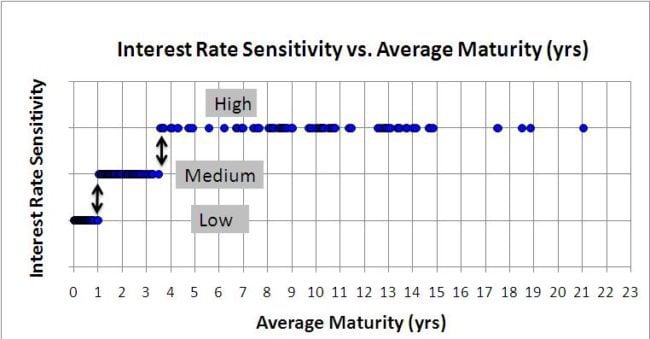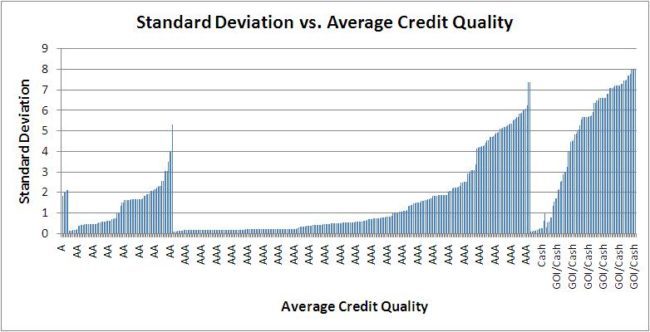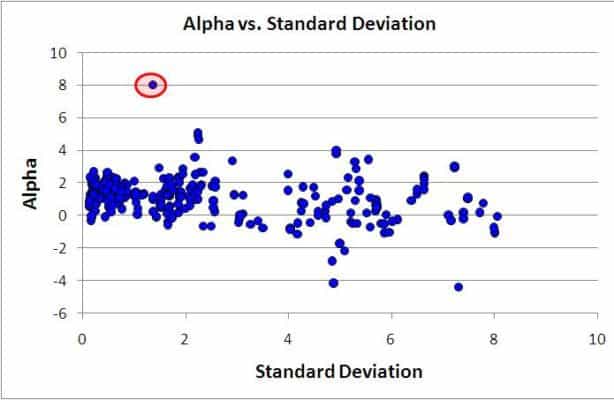Last Updated on September 5, 2021 at 8:28 pm
Here is a risk vs. reward analysis of debt mutual funds. This is a companion post to:
- (Equity) Mutual Fund Investing: Risk vs. Reward vs. Volatility and
- The key to successful mutual fund investing
All the posts are based on Value Research Online’s fund selector page.
First some definitions.
Average Maturity
A debt mutual fund holds debt securities with differing maturity periods. The weighted average of the maturity periods (taking into account percentage allocation) is known as the average maturity and is typically expressed in years. Higher the average maturity, the more sensitive the fund is to interest rate movements.
Join 32,000+ readers and get free money management solutions delivered to your inbox! Subscribe to get posts via email! (Link takes you to our email sign-up form)
🔥Want to create a complete financial plan? Learn goal-based investing? Exclusive access to our DIY tools? Increase your income with your skills? Use this link to enjoy massive discounts on our robo-advisory tool & courses! 🔥
Modified Duration
My favorite debt fund metric. See: How to Select Debt Mutual Funds Suitable For Your Financial Goals?
Measured in years, modified duration is a measurement of a bond’s sensitivity to movements in interest rates. For example, a bond with a modified duration of 5.2 years can be expected to undergo a 5.2% movement in price for each 1% movement in interest rates. The longer the modified duration (in years), the more sensitive a bond’s price to changes in interest rates. Source: Invesco Perpetual
Although VRonline lists modified duration of debt mutual funds in their respective fund page, it only offers an ‘interest rate sensitivity’ score (1: low; 2: medium; 3: high) in its fund selector page. I am assuming this is derived from the modified duration.
Standard Deviation
Knowledge of the standard deviation is the key to successful mutual fund investing.
The standard deviation is a measure of how much monthly returns deviate from their average. It can be interpreted as the uncertainty or the error associated with the expected return.
For example, if standard deviation over a period of 3 years is 1% for a debt fund, and the associated return is 9%, 68 times out of 100, returns would have varied from (9-1 = 8%) to (9+1 = 10%).
So higher the standard deviation, higher the volatility. Higher the uncertainty in the expected return.
Alpha
Alpha is a risk-adjusted measure of excess returns above the benchmark.
“A positive alpha of 1.0 means the fund has outperformed its benchmark index by 1%. Correspondingly, a similar negative alpha would indicate an underperformance of 1%” – Investopedia
Now on to the graphs
Average Maturity vs. Standard Deviation
Both axes are in log scale for clarity. Higher the standard deviation, higher the average maturity. I should have probably switched the X and Y axes since the standard deviation is a result of the choices made while selecting the portfolio. Too lazy to replot!
Funds which investment in long-term debt paper are susceptible to interest rate movements and hence have a higher standard deviation.
Notice the shaded rectangle. This bounds all funds with an average maturity of 1 year and a standard deviation of 1%.
This represents ‘low-risk’ debt funds and can be used for short-term (< 5 years) financial goals. Lower the duration, lower should be the standard deviation and the average maturity.
The standard deviation arises not just from changes in the average maturity of the portfolio. It is also sensitive to interest rate risk, especially at higher average maturities!
Some funds are way off from the rest of the bunch. One such fund is encircled in red. This is a pure debt fund of fund scheme:
Interest Rate Sensitivity vs. Standard Deviation

The data is bunched into three categories by VRonline: Low, medium and high.
In general, higher the interest rate sensitivity, higher the standard deviation.
Most funds with standard deviation
- less than 1% have low interest rate sensitivity
- between 1-3% have medium interest rate sensitivity
- greater than 3% have high interest rate sensitivity
The demarcation becomes even clearer below.
Interest Rate Sensitivity vs. Average Maturity
Fund with Average Maturity,
- less than 1 year have low interest rate sensitivity
- between 1-3.5 years have medium interest rate sensitivity
- above 3.5 years have high interest rate sensitivity
Standard Deviation vs. Average Credit Quality
The quality of the debt paper, as quantified by credit ratings (AAA, AA etc.), give an idea about the return potential of the fund and also its sensitivity to interest rate movements.
Notice that the average credit quality is a poor indicator of volatility. Funds with average AAA quality have standard deviations ranging from 0.13% to 7.39%. A huge spread!
Therefore just because a fund has average credit quality of AAA, does not mean it is ‘safe’! The average maturity also matters.
Average Maturity (years) vs. Average Credit Quality
Notice again the huge spread in each credit rating category.
Interest Rate Sensitivity vs. Average Credit Quality
There are a few funds with average credit rating of AAA and high interest rate sensitivity. Tread carefully with those funds.
So if you wish to hold a ‘safe’ debt mutual fund, it should have
- high credit rating
- low average maturity and
- low interest rate sensitivity
Typically ‘banking and PSU’ debt mutual funds satisfy these requirements.
Alpha vs. Standard Deviation
Typically most debt funds manage to beat their respective indices like equity funds. Higher the standard deviation, more is the spread in the alpha values, which is understandable.
The point encircles in red belongs to Sundaram Gilt Fund. Mr. Raghu Ramamurthy alerted me to the fact that this fund, a short-term gilt fund produced an astonishing return of 19.22% in 2013!!
While I am still trying to figure this out, all I know is that the fund was fully into reverse repo/CBLO holdings up to the July 2013 crash and then switched fully into short term GOI bonds. While this definitely contributed to the high returns, I am not sure if this is the only reason.

Use our Robo-advisory Tool to create a complete financial plan! ⇐More than 3,000 investors and advisors use this! Use the discount code: robo25 for a 20% discount. Plan your retirement (early, normal, before, and after), as well as non-recurring financial goals (such as child education) and recurring financial goals (like holidays and appliance purchases). The tool would help anyone aged 18 to 80 plan for their retirement, as well as six other non-recurring financial goals and four recurring financial goals, with a detailed cash flow summary.
🔥You can also avail massive discounts on our courses and the freefincal investor circle! 🔥& join our community of 8000+ users!
Track your mutual funds and stock investments with this Google Sheet!
We also publish monthly equity mutual funds, debt and hybrid mutual funds, index funds, and ETF screeners, as well as momentum and low-volatility stock screeners.
You can follow our articles on Google News

We have over 1,000 videos on YouTube!

Join our WhatsApp Channel



- Do you have a comment about the above article? Reach out to us on Twitter: @freefincal or @pattufreefincal
- Have a question? Subscribe to our newsletter using the form below.
- Hit 'reply' to any email from us! We do not offer personalised investment advice. We can write a detailed article without mentioning your name if you have a generic question.
Join 32,000+ readers and get free money management solutions delivered to your inbox! Subscribe to get posts via email! (Link takes you to our email sign-up form)
About The Author
 Dr M. Pattabiraman (PhD) is the founder, managing editor and primary author of freefincal. He is an associate professor at the Indian Institute of Technology, Madras. He has over 13 years of experience publishing news analysis, research and financial product development. Connect with him via Twitter(X), LinkedIn, or YouTube. Pattabiraman has co-authored three print books: (1) You can be rich too with goal-based investing (CNBC TV18) for DIY investors. (2) Gamechanger for young earners. (3) Chinchu Gets a Superpower! for kids. He has also written seven other free e-books on various money management topics. He is a patron and co-founder of “Fee-only India,” an organisation promoting unbiased, commission-free, AUM-independent investment advice.
Dr M. Pattabiraman (PhD) is the founder, managing editor and primary author of freefincal. He is an associate professor at the Indian Institute of Technology, Madras. He has over 13 years of experience publishing news analysis, research and financial product development. Connect with him via Twitter(X), LinkedIn, or YouTube. Pattabiraman has co-authored three print books: (1) You can be rich too with goal-based investing (CNBC TV18) for DIY investors. (2) Gamechanger for young earners. (3) Chinchu Gets a Superpower! for kids. He has also written seven other free e-books on various money management topics. He is a patron and co-founder of “Fee-only India,” an organisation promoting unbiased, commission-free, AUM-independent investment advice.Our flagship course! Learn to manage your portfolio like a pro to achieve your goals regardless of market conditions! ⇐ More than 3,500 investors and advisors are part of our exclusive community! Get clarity on how to plan for your goals and achieve the necessary corpus no matter the market condition!! Watch the first lecture for free! One-time payment! No recurring fees! Life-long access to videos! Reduce fear, uncertainty and doubt while investing! Learn how to plan for your goals before and after retirement with confidence.
Increase your income by getting people to pay for your skills! ⇐ More than 800 salaried employees, entrepreneurs and financial advisors are part of our exclusive community! Learn how to get people to pay for your skills! Whether you are a professional or small business owner seeking more clients through online visibility, or a salaried individual looking for a side income or passive income, we will show you how to achieve this by showcasing your skills and building a community that trusts and pays you. (watch 1st lecture for free). One-time payment! No recurring fees! Life-long access to videos!
Our book for kids: “Chinchu Gets a Superpower!” is now available!


Must-read book even for adults! This is something that every parent should teach their kids right from their young age. The importance of money management and decision making based on their wants and needs. Very nicely written in simple terms. - Arun.Buy the book: Chinchu gets a superpower for your child!
How to profit from content writing: Our new ebook is for those interested in getting a side income via content writing. It is available at a 50% discount for Rs. 500 only!
Do you want to check if the market is overvalued or undervalued? Use our market valuation tool (it will work with any index!), or get the Tactical Buy/Sell timing tool!
We publish monthly mutual fund screeners and momentum, low-volatility stock screeners.
About freefincal & its content policy. Freefincal is a News Media organisation dedicated to providing original analysis, reports, reviews and insights on mutual funds, stocks, investing, retirement and personal finance developments. We do so without conflict of interest and bias. Follow us on Google News. Freefincal serves more than three million readers a year (5 million page views) with articles based only on factual information and detailed analysis by its authors. All statements made will be verified with credible and knowledgeable sources before publication. Freefincal does not publish paid articles, promotions, PR, satire or opinions without data. All opinions will be inferences backed by verifiable, reproducible evidence/data. Contact Information: To get in touch, please use our contact form. (Sponsored posts or paid collaborations will not be entertained.)
Connect with us on social media
- Twitter @freefincal
- Subscribe to our YouTube Videos
- Posts feed via Feedburner.
Our publications
You Can Be Rich Too with Goal-Based Investing
 Published by CNBC TV18, this book is designed to help you ask the right questions and find the correct answers. Additionally, it comes with nine online calculators, allowing you to create custom solutions tailored to your lifestyle. Get it now.
Published by CNBC TV18, this book is designed to help you ask the right questions and find the correct answers. Additionally, it comes with nine online calculators, allowing you to create custom solutions tailored to your lifestyle. Get it now.Gamechanger: Forget Startups, Join Corporate & Still Live the Rich Life You Want
 This book is designed for young earners to get their basics right from the start! It will also help you travel to exotic places at a low cost! Get it or gift it to a young earner.
This book is designed for young earners to get their basics right from the start! It will also help you travel to exotic places at a low cost! Get it or gift it to a young earner.Your Ultimate Guide to Travel
 This is an in-depth exploration of vacation planning, including finding affordable flights, budget accommodations, and practical travel tips. It also examines the benefits of travelling slowly, both financially and psychologically, with links to relevant web pages and guidance at every step. Get the PDF for Rs 300 (instant download)
This is an in-depth exploration of vacation planning, including finding affordable flights, budget accommodations, and practical travel tips. It also examines the benefits of travelling slowly, both financially and psychologically, with links to relevant web pages and guidance at every step. Get the PDF for Rs 300 (instant download)




